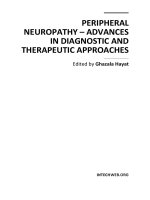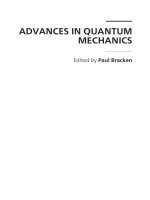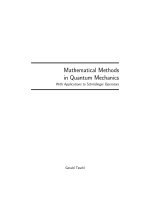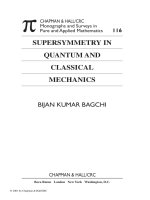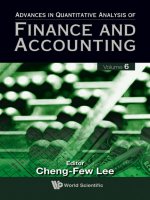ADVANCES IN QUANTUM MECHANICS pot
Bạn đang xem bản rút gọn của tài liệu. Xem và tải ngay bản đầy đủ của tài liệu tại đây (21.97 MB, 790 trang )
ADVANCES IN QUANTUM
MECHANICS
Edited by Paul Bracken
Advances in Quantum Mechanics
/>Edited by Paul Bracken
Contributors
Tokuzo Shimada, Gabino Torres-Vega, Francisco Bulnes, Inge S. Helland, Rodolfo Esquivel, Nelson Flores-Gallegos,
Stephen Fulling, Fernando Mera, Jan Jerzy Slawianowski, Vasyl Kovalchuk, Fujii, Argyris Nicolaidis, Rafael De Lima
Rodrigues, Constancio Miguel Arizmendi, Omar Gustavo Zabaleta, Peter Enders, GianCarlo Ghirardi, Donald Jack
Kouri, Cynthia Whitney, Francisco De Zela, Douglas Singleton, Seyed Mohammad Motevalli, Yasuteru Shigeta, Valeriy
Sbitnev, Jonathan Bentwich, Miloš Vaclav Lokajíček, John Ralston, L. M. Arevalo Aguilar, Carlos Robledo Sanchez, Paulo
Cesar Garcia Quijas, Balmakov, Maricel Agop, Bjorn Jensen, Sergio Curilef, Flavia Pennini, Paul Bracken
Published by InTech
Janeza Trdine 9, 51000 Rijeka, Croatia
Copyright © 2013 InTech
All chapters are Open Access distributed under the Creative Commons Attribution 3.0 license, which allows users to
download, copy and build upon published articles even for commercial purposes, as long as the author and publisher
are properly credited, which ensures maximum dissemination and a wider impact of our publications. However, users
who aim to disseminate and distribute copies of this book as a whole must not seek monetary compensation for such
service (excluded InTech representatives and agreed collaborations). After this work has been published by InTech,
authors have the right to republish it, in whole or part, in any publication of which they are the author, and to make
other personal use of the work. Any republication, referencing or personal use of the work must explicitly identify the
original source.
Notice
Statements and opinions expressed in the chapters are these of the individual contributors and not necessarily those
of the editors or publisher. No responsibility is accepted for the accuracy of information contained in the published
chapters. The publisher assumes no responsibility for any damage or injury to persons or property arising out of the
use of any materials, instructions, methods or ideas contained in the book.
Publishing Process Manager Danijela Duric
Technical Editor InTech DTP team
Cover InTech Design team
First published April, 2013
Printed in Croatia
A free online edition of this book is available at www.intechopen.com
Additional hard copies can be obtained from
Advances in Quantum Mechanics, Edited by Paul Bracken
p. cm.
ISBN 978-953-51-1089-7
free online editions of InTech
Books and Journals can be found at
www.intechopen.com
Contents
Preface IX
Section 1 The Classical-Quantum Correspondence 1
Chapter 1 Classical and Quantum Conjugate Dynamics – The Interplay
Between Conjugate Variables 3
Gabino Torres-Vega
Chapter 2 Classical and Quantum Correspondence in Anisotropic
Kepler Problem 23
Keita Sumiya, Hisakazu Uchiyama, Kazuhiro Kubo and Tokuzo
Shimada
Chapter 3 Charathéodory’s “Royal Road” to the Calculus of Variations: A
Possible Bridge Between Classical and Quantum Physics 41
Francisco De Zela
Chapter 4 The Improvement of the Heisenberg Uncertainty Principle 67
L. M. Arévalo Aguilar, C. P. García Quijas and Carlos Robledo-
Sanchez
Section 2 The Schrödinger Equation 79
Chapter 5 Schrödinger Equation as a Hamiltonian System, Essential
Nonlinearity, Dynamical Scalar Product and some Ideas of
Decoherence 81
Jan J. Sławianowski and Vasyl Kovalchuk
Chapter 6 Schrödinger Equation and (Future) Quantum Physics 105
Miloš V. Lokajíček, Vojtěch Kundrát and Jiří Procházka
Chapter 7 Quantum Damped Harmonic Oscillator 133
Kazuyuki Fujii
Section 3 Path Integrals 157
Chapter 8 The Schwinger Action Principle and Its Applications to
Quantum Mechanics 159
Paul Bracken
Chapter 9 Generalized Path Integral Technique: Nanoparticles Incident on
a Slit Grating, Matter Wave Interference 183
Valeriy I. Sbitnev
Chapter 10 Quantum Intentionality and Determination of Realities in the
Space-Time Through Path Integrals and Their Integral
Transforms 213
Francisco Bulnes
Section 4 Perturbation Theory 245
Chapter 11 Convergence of the Neumann Series for the Schrödinger
Equation and General Volterra Equations in
Banach Spaces 247
Fernando D. Mera and Stephen A. Fulling
Chapter 12 Quantum Perturbation Theory in Fluid Mixtures 269
S. M. Motevalli and M. Azimi
Chapter 13 Quantal Cumulant Mechanics as Extended
Ehrenfest Theorem 293
Yasuteru Shigeta
Chapter 14 Unruh Radiation via WKB Method 317
Douglas A. Singleton
Section 5 Foundations of Quantum Mechanics 333
Chapter 15 A Basis for Statistical Theory and Quantum Theory 335
Inge S. Helland
Chapter 16 Relational Quantum Mechanics 361
A. Nicolaidis
ContentsVI
Chapter 17 On the Dual Concepts of 'Quantum State' and 'Quantum
Process' 371
Cynthia Kolb Whitney
Chapter 18 The Computational Unified Field Theory (CUFT): A Candidate
'Theory of Everything' 395
Jonathan Bentwich
Chapter 19 Emergent un-Quantum Mechanics 437
John P. Ralston
Chapter 20 The Wigner-Heisenberg Algebra in Quantum Mechanics 477
Rafael de Lima Rodrigues
Chapter 21 New System-Specific Coherent States by Supersymmetric
Quantum Mechanics for Bound State Calculations 499
Chia-Chun Chou, Mason T. Biamonte, Bernhard G. Bodmann and
Donald J. Kouri
Section 6 Quantization and Entanglement 519
Chapter 22 Quantum Dating Market 521
C. M. Arizmendi and O. G. Zabaleta
Chapter 23 Quantization as Selection Rather than
Eigenvalue Problem 543
Peter Enders
Chapter 24 Entanglement, Nonlocality, Superluminal Signaling
and Cloning 565
GianCarlo Ghirardi
Chapter 25 The Husimi Distribution: Development and Applications 595
Sergio Curilef and Flavia Pennini
Section 7 Quantum Information and Related Topics 621
Chapter 26 The Quantum Mechanics Aspect of Structural Transformations
in Nanosystems 623
M. D. Bal’makov
Contents VII
Chapter 27 Decoding the Building Blocks of Life from the Perspective of
Quantum Information 641
Rodolfo O. Esquivel, Moyocoyani Molina-Espíritu, Frank Salas,
Catalina Soriano, Carolina Barrientos, Jesús S. Dehesa and José A.
Dobado
Chapter 28 The Theoretical Ramifications of the Computational Unified
Field Theory 671
Jonathan Bentwich
Chapter 29 Shannon Informational Entropies and Chemical
Reactivity 683
Nelson Flores-Gallegos
Chapter 30 A Novel Isospectral Deformation Chain in Supersymmetric
Quantum Mechanics 707
Bjørn Jensen
Chapter 31 Quantum Effects Through a Fractal Theory of Motion 723
M. Agop, C.Gh. Buzea, S. Bacaita, A. Stroe and M. Popa
ContentsVIII
Preface
It can be stated that one of the greatest creations of twentieth century physics has been quan‐
tum mechanics. This has brought with it a revolutionary view of the physical world in its
wake initiated by the work of people like Bohr, Schrödinger, Heisenberg and Born, Pauli and
Dirac and many others. The development of quantum mechanics has taken physics in a vastly
new direction from that of classical physics from the very start. This is clear from the compli‐
cated mathematical formalism of quantum mechanics and the intrinsic statistical nature of
measurement theory. In fact, there continue at present to be many developments in the subject
of a very fundamental nature, such as implications for the foundations of physics, physics of
entanglement, geometric phases, gravity and cosmology and elementary particles as well.
Quantum mechanics has had a great impact on technology and in applications to other fields
such as chemistry and biology. The intention of the papers in this volume is to give research‐
ers in quantum mechanics, mathematical physics and mathematics an overview and introduc‐
tion to some of the topics which are of current interest in this area.
Of the 29 chapters, the range of topics to be presented is limited to discussions on the founda‐
tions of quantum mechanics, the Schrödinger equation and quantum physics, the relationship
of the classical-quantum correspondence, the impact of the path integral concept on quantum
mechanics, perturbation theory, quantization and finally some informational-entropy aspects
and application to biophysics. Many of the papers could be placed into more than one of these
sections, so their breadth is quite substantial.
The book has been put together by a large international group of invited authors and it is neces‐
sary to thank them for their hard work and contributions to the book. I gratefully acknowledge
with thanks to the assistance provided by Ms. Danijela Duric who was publishing manager dur‐
ing the publishing process, and Intech publishing group for the publication of the book.
Professor Paul Bracken
Department of Mathematics,
University of Texas, Edinburg, TX
USA
Section 1
The Classical-Quantum Correspondence
Chapter 1
Classical and Quantum Conjugate Dynamics –
The Interplay Between Conjugate Variables
Gabino Torres-Vega
Additional information is available at the end of the chapter
/>1. Introduction
There are many proposals for writing Classical and Quantum Mechanics in the same lan‐
guage. Some approaches use complex functions for classical probability densities [1] and
other define functions of two variables from single variable quantum wave functions [2,3].
Our approach is to use the same concepts in both types of dynamics but in their own realms,
not using foreign unnatural objects. In this chapter, we derive many inter relationships be‐
tween conjugate variables.
1.1. Conjugate variables
An important object in Quantum Mechanics is the eigenfunctions set
{|
n >
}
n=0
∞
of a Hermi‐
tian operator F
^
. These eigenfunctions belong to a Hilbert space and can have several repre‐
sentations, like the coordinate representation ψ
n
(
q
)
=
q | n . The basis vector used to provide
the coordinate representation,
|
q >, of the wave function are themselves eigenfunctions of
the coordinate operator Q
^
We proceed to define the classical analogue of both objects, the
eigenfunction and its support.
Classical motion takes place on the associated cotangent space T
*
Q with variable z =
(
q, p
)
,
where q and p are n dimensional vectors representing the coordinate and momentum of
point particles. We can associate to a dynamical variable F
(
z
)
its eigensurface, i.e. the level
set
Σ
F
(
f
)
=
{
z ∈T
*
Q
|
F
(
z
)
= f
}
(1)
© 2013 Torres-Vega; licensee InTech. This is an open access article distributed under the terms of the Creative
Commons Attribution License ( which permits unrestricted use,
distribution, and reproduction in any medium, provided the original work is properly cited.
Where f is a constant, one of the values that F
(
z
)
can take. This is the set of points in phase
space such that when we evaluate F
(
z
)
, we obtain the value f . Examples of these eigensurfa‐
ces are the constant coordinate surface, q= X , and the energy shell, H
(
z
)
= E, the surface on
which the evolution of classical systems take place. These level sets are the classical analogues
of the support of quantum eigenfunctions in coordinate or momentum representations.
Many dynamical variables come in pairs. These pairs of dynamical variables are related
through the Poisson bracket. For a pair of conjugate variables, the Poisson bracket is equal to
one. This is the case for coordinate and momentum variables, as well as for energy and time.
In fact, according to Hamilton’s equations of motion, and the chain rule, we have that
{
t, H
}
=∑
i
(
∂t
∂q
i
∂ H
∂ p
i
-
∂ H
∂q
i
∂t
∂ p
i
)
=∑
i
(
dt
dq
i
dq
i
dt
+
d p
i
dt
dt
d p
i
)
=
dt
dt
=1
(2)
Now, a point in cotangent space can be specified as the intersection of 2n hypersurfaces. A
set of 2n independent, intersecting, hypersurfaces can be seen as a coordinate system in co‐
tangent space, as is the case for the hyper surfaces obtained by fixing values of coordinate
and momentum, i.e. the phase space coordinate system with an intersection at z =
(
q, p
)
. We
can think of alternative coordinate systems by considering another set of conjugate dynami‐
cal variables, as is the case of energy and time.
Thus, in general, the T
*
Q points can be represented as the intersection of the eigensurfaces
of the pair of conjugate variables F and G,
Σ
FG
(
f , g
)
=
{
z ∈T
*
Q
|
F
(
z
)
= f , G
(
z
)
= g
}
. (3)
A point in this set will be denoted as an abstract bra
(
f , g
|
, such that
(
f , g
|
u
)
means the
function u
(
f , g
)
.
We can also have marginal representations of functions in phase space by using the eigen‐
surfaces of only one of the functions,
Σ
F
(
f
)
=
{
z ∈T
*
Q
|
F
(
z
)
= f
}
, and Σ
G
(
g
)
=
{
z ∈T
*
Q | G
(
z
)
= g
}
.
A point in the set Σ
F
(
f
)
Σ
G
(
g
)
will be denoted by the bra
(
f
| (
g
|
and an object like
(
f | u
)
(
g
|
u
)
will mean the f g dependent function u
(
f
)
u
(
g
)
.
1.2. Conjugate coordinate systems
It is usual that the origin of one of the variables of a pair of conjugate variables is not well
defined. This happens, for instance, with the pair of conjugate variables q and p. Even
though the momentum can be well defined, the origin of the coordinate is arbitrary on the
trajectory of a point particle, and it can be different for each trajectory. A coordinate system
fixes the origin of coordinates for all of the momentum eigensurfaces.
Advances in Quantum Mechanics4
A similar situation is found with the conjugate pair energy-time. Usually the energy is well
defined in phase space but time is not. In a previous work, we have developed a method for
defining a time coordinate in phase space [4]. The method takes the hypersurface q
1
= X ,
where X is fixed, as the zero time eigensurface and propagates it forward and backward in
time generating that way a coordinate system for time in phase space.
Now, recall that any phase space function G
(
z
)
generates a motion in phase space through a
set of symplectic system of equations, a dynamical system,
dz
df
= X
G
, X
G
=
(
∂G
∂ p
, -
∂G
∂q
)
,
(4)
where f is a variable with the same units as the conjugate variable F
(
z
)
. You can think of
G
(
z
)
as the Hamiltonian for a mechanical system and that f is the time. For classical sys‐
tems, we are considering conjugate pairs leading to conjugate motions associated to each
variable with the conjugate variable serving as the evolution parameter (see below). This
will be applied to the energy-time conjugate pair. Let us derive some properties in which the
two conjugate variables participate.
1.3. The interplay between conjugate variables
Some relationships between a pair of conjugate variables are derived in this section. We will
deal with general F
(
z
)
and G
(
z
)
conjugate variables, but the results can be applied to coordi‐
nate and momentum or energy and time or to any other conjugate pair.
The magnitude of the vector field
|
X
G
|
is the change of length along the f direction
|
X
G
|
=
dq
i
df
dq
i
df
+
d p
i
df
d p
i
df
=
dl
F
df
,
(5)
where dl
F
=
(
dq
i
)
2
+
(
d p
i
)
2
is the length element.
A unit density with the eigensurface Σ
G
(
g
)
as support
(
z
|
g
)
=δ
(
z - v
)
, v ∈Σ
G
(
g
)
(6)
is the classical analogue of the corresponding quantum eigenstate in coordinate
q | g and
momentum
p | g representations. When G
(
z
)
is evaluated at the points of the support of
(
z
|
g
)
, we get the value g. We use a bra-ket like notation to emphasise the similarity with
the quantum concepts.
The overlap between a probability density with an eigenfunction of F
^
or G
^
provides margin‐
al representations of a probability density,
Classical and Quantum Conjugate Dynamics – The Interplay Between Conjugate Variables
/>5
ρ
(
f
)
≔
(
f | ρ
)
≔∫
(
f | z
)(
z | ρ
)
dz =∫δ
(
z - f
)
ρ
(
z
)
dz , f ∈∑
F
(
f
)
.
(7)
ρ
(
g
)
≔
(
g | ρ
)
≔∫
(
g | z
)(
z | ρ
)
dz =∫δ
(
z - g
)
ρ
(
z
)
dz , g ∈∑
G
(
g
)
.
(8)
But, a complete description of a function in T
*
Q is obtained by using the two dimensions
unit density
(
z | f , g
)
=δ
(
z -
(
f , g
))
, the eigenfunction of a location in phase space,
ρ
(
f , g
)
≔
(
f , g | ρ
)
≔∫
(
f , g | z
)(
z | ρ
)
dz =∫δ
(
z -
(
f , g
))
ρ
(
z
)
dz ,
(
f , g
)
∈ ∑
FG
(
f , g
)
.
(9)
In this way, we have the classical analogue of the quantum concepts of eigenfunctions of op‐
erators and the projection of vectors on them.
1.4. Conjugate motions
Two dynamical variables with a constant Poisson bracket between them induce two types of
complementary motions in phase space. Let us consider two real functions F(z) and G(z) of
points in cotangent space z ∈ T
*
Q of a mechanical system, and a unit Poisson bracket be‐
tween them,
{
F, G
}
=
∂ F
∂q
i
∂G
∂ p
i
-
∂G
∂q
i
∂ F
∂ p
i
=1 ,
(10)
valid on some domain D =D
(
∂ F
∂q
i
)
∩D
(
∂ F
∂q
i
)
∩D
(
∂ F
∂q
i
)
∩D
(
∂ F
∂q
i
)
, according to the considered func‐
tions F and G. The application of the chain rule to functions of p and q, and Eq. (10), sug‐
gests two ways of defining dynamical systems for functions F and G that comply with the
unit Poisson bracket. One of these dynamical systems is
d p
i
dF
= -
∂G
∂q
i
,
dq
i
dF
=
∂G
∂ p
i
.
(11)
With these replacements, the Poisson bracket becomes the derivative of a function with re‐
spect to itself
{
F, G
}
=
∂ F
∂q
i
∂q
i
∂ F
+
∂ p
i
∂ F
∂ F
∂ p
i
=
dF
dF
=1 .
(12)
Advances in Quantum Mechanics6
Note that F is at the same time a parameter in terms of which the motion of points in phase
space is written, and also the conjugate variable to G.
We can also define other dynamical system as
d p
i
dG
=
∂ F
∂q
i
,
dq
i
dG
= -
∂ F
∂ p
i
.
(13)
Now, G is the shift parameter besides of being the conjugate variable to F . This also renders
the Poisson bracket to the identity
{
F, G
}
=
d p
i
dG
∂G
∂ p
i
+
dq
i
dG
∂G
∂q
i
=
dG
dG
=1 .
(14)
The dynamical systems and vector fields for the motions just defined are
dz
dG
= X
F
, X
F
=
(
-
∂ F
∂ p
i
,
∂ F
∂q
i
)
, and
dz
dF
= X
G
, X
G
=
(
∂G
∂ p
i
, -
∂G
∂q
i
)
(15)
Then, the motion along one of the F or G directions is determined by the corresponding
conjugate variable. These vector fields in general are not orthogonal, nor parallel.
If the motion of phase space points is governed by the vector field (15), F remains constant
because
dF
dG
=
∂ F
∂q
i
∂q
i
∂G
+
∂ F
∂ p
i
∂ p
i
∂G
=
∂ p
i
∂G
∂q
i
∂G
-
∂q
i
∂G
∂ p
i
∂G
=0 .
(16)
In contrast, when motion occurs in the F direction, by means of Eq. (16), it is the G variable
the one that remains constant because
dG
dF
=
∂G
∂q
i
∂q
i
∂ F
+
∂G
∂ p
i
∂ p
i
∂ F
= -
∂ p
i
∂ F
∂q
i
∂ F
+
∂q
i
∂ F
∂ p
i
∂ F
=0 .
(17)
Hence, motion originated by the conjugate variables F
(
z
)
and G
(
z
)
occurs on the shells of
constant F
(
z
)
or of constant G
(
z
)
, respectively.
The divergence of these vector fields is zero,
∇ ∙X
F
= -
∂
∂q
i
∂ F
∂ p
i
+
∂
∂ p
i
∂ F
∂q
i
=0 , ∇ ∙ X
G
=
∂
∂q
i
∂G
∂ p
i
-
∂
∂ p
i
∂G
∂q
i
=0 .
(18)
Classical and Quantum Conjugate Dynamics – The Interplay Between Conjugate Variables
/>7
Thus, the motions associated to each of these conjugate variables preserve the phase space
area.
A constant Poisson bracket is related to the constancy of a cross product because
X
G
∧ X
F
=
dz
dF
∧
dz
dG
=
|
q
^
p
^
n
^
∂G
∂ p
-
∂G
∂q
0
-
∂ F
∂ p
∂ F
∂q
0
|
=n
^
(
∂G
∂ p
∂ F
∂q
-
∂G
∂q
∂ F
∂ p
)
=n
^
{
F, G
}
.
(19)
where n
^
is the unit vector normal to the phase space plane. Then, the magnitudes of the vec‐
tor fields and the angle between them changes in such a way that the cross product remains
constant when the Poisson bracket is equal to one, i.e. the cross product between conjugate
vector fields is a conserved quantity.
The Jacobian for transformations from phase space coordinates to
(
f , g
)
variables is one for
each type of motion:
J =
|
∂q
∂ f
∂ p
∂ f
∂q
∂ g
∂ p
∂ g
|
=
|
∂G
∂ p
-
∂G
∂q
∂q
∂ g
∂ p
∂ g
|
=
∂G
∂ p
∂ p
∂ g
+
∂G
∂q
∂q
∂ g
=
dG
dg
=1 ,
(20)
and
J =
|
∂q
∂ f
∂ p
∂ f
∂q
∂ g
∂ p
∂ g
|
=
|
∂q
∂ f
∂ p
∂ f
-
∂ F
∂ p
∂ F
∂q
|
=
∂ F
∂q
∂q
∂ f
+
∂ F
∂ p
∂ p
∂ f
=
dF
df
=1 .
(21)
We have seen some properties related to the motion of phase space points caused by conju‐
gate variables.
1.5. Poisson brackets and commutators
We now consider the use of commutators in the classical realm.
The Poisson bracket can also be written in two ways involving a commutator. One form is
{
F, G
}
=
(
∂G
∂ p
∂
∂q
-
∂G
∂q
∂
∂ p
)
F = L
G
, F =1 ,
(22)
Advances in Quantum Mechanics8
and the other is
{
F, G
}
=
(
∂ F
∂q
∂
∂ p
-
∂ F
∂ p
∂
∂q
)
G = L
F
, G =1 .
(23)
With these, we have introduced the Liouville type operators
L
F
=
∂ F
∂q
∂
∂ p
-
∂ F
∂ p
∂
∂q
= X
F
∙∇, and L
G
=
∂G
∂ p
∂
∂q
-
∂G
∂q
∂
∂ p
= X
G
∙∇ .
(24)
These are Lie derivatives in the directions of X
F
and X
G
, respectively. These operators gen‐
erate complementary motion of functions in phase space. Note that now, we also have oper‐
ators and commutators as in Quantum Mechanics.
Conserved motion of phase space functions moving along the f or g directions can be ach‐
ieved with the above Liouvillian operators as
∂
∂ f
= - L
G
, and
∂
∂ g
= - L
F
.
(25)
Indeed, with the help these definitions and of the chain rule, we have that the total deriva‐
tive of functions vanishes, i.e. the total amount of a function is conserved,
d
df
=
dq
df
∂
∂q
+
dp
df
∂
∂ p
+
∂
∂ f
=
dz
df
∙∇ +
∂
∂ f
= X
G
∙∇ +
∂
∂ f
=L
G
+
∂
∂ f
= -
∂
∂ f
+
∂
∂ f
=0 ,
(26)
and
d
dg
=
dq
dg
∂
∂q
+
dp
dg
∂
∂ p
+
∂
∂ g
=
dz
dg
∙∇ +
∂
∂ g
= X
F
∙∇ +
∂
∂ g
=L
F
+
∂
∂ g
= -
∂
∂ g
+
∂
∂ g
=0 .
(27)
Also, note that for any function u
(
z
)
of a phase space point z, we have that
L
F
, u
(
z
)
=L
F
u
(
z
)
= X
F
∙∇u
(
z
)
=
dz
dG
∙∇u
(
z
)
= -
∂
∂ g
u
(
z
)
,
(28)
and
L
G
, u
(
z
)
=L
G
u
(
z
)
= X
G
∙∇u
(
z
)
=
dz
dF
∙∇u
(
z
)
= -
∂
∂ f
u
(
z
)
,
(29)
which are the evolution equations for functions along the conjugate directions f and g.
These are the classical analogues of the quantum evolution equation
d
dt
=
1
iℏ
, H
^
for time
dependent operators. The formal solutions to these equations are
Classical and Quantum Conjugate Dynamics – The Interplay Between Conjugate Variables
/>9
u
(
z; g
)
=e
-gL
F
u
(
z
)
, and u
(
z; f
)
=e
- f L
G
u
(
z
)
.
(30)
With these equations, we can now move a function u
(
z
)
on T
*
Q in such a way that the
points of their support move according to the dynamical systems Eqs. (15) and the total
amount of u is conserved.
1.6. The commutator as a derivation and its consequences
As in quantum theory, we have found commutators and there are many properties based on
them, taking advantage of the fact that a commutator is a derivation.
Since the commutator is a derivation, for conjugate variables F
(
z
)
and G
(
z
)
we have that, for
integer n,
L
G
n
, F =n L
G
n-1
, L
G
, F
n
=n F
n-1
, L
F
n
, G =n L
F
n-1
, L
F
, G
n
=n G
n-1
.
(31)
Based on the above equalities, we can get translation relationships for functions on T
*
Q. We
first note that, for a holomorphic function u
(
x
)
= ∑
n=0
∞
u
n
x
n
,
u
(
L
G
)
, F = ∑
n=0
∞
u
n
L
G
n
, F = ∑
n=0
∞
nu
n
L
G
n-1
=u
'
(
L
G
)
.
(32)
In particular, we have that
e
f L
G
, F = f e
f L
G
.
(33)
Then, e
f L
G
is the eigenfunction of the commutator ∙, F with eigenvalue f .
From Eq. (32), we find that
u
(
L
G
)
F - Fu
(
L
G
)
=u
'
(
L
G
)
.
(34)
But, if we multiply by u
-1
(
L
G
)
from the right, we arrive to
u
(
L
G
)
Fu
-1
(
L
G
)
= F + u
'
(
L
G
)
u
-1
(
L
G
)
.
(35)
This is a generalized version of a shift of F, and the classical analogue of a generalization of
the quantum Weyl relationship. A simple form of the above equality, a familiar form, is ob‐
tained with the exponential function, i.e.
e
f L
G
Fe
- f L
G
= F + f .
(36)
Advances in Quantum Mechanics10
This is a relationship that indicates how to translate the function F
(
z
)
as an operator. When this
equality is acting on the number one, we arrive at the translation property for F as a function
F
(
z; f
)
=
(
e
f L
G
F
(
z
))
= F
(
z
)
e
f L
G
1 + f e
f L
G
1= F
(
z
)
+ f .
(37)
This implies that
d
df
F
(
z; f
)
=1 ,
(38)
i.e., up to an additive constant, f is the value of F
(
z
)
itself, one can be replaced by the other
and actually they are the same object, with f the classical analogue of the spectrum of a
quantum operator.
Continuing in a similar way, we can obtain the relationships shown in the following diagram
Diagram 1.
Classical and Quantum Conjugate Dynamics – The Interplay Between Conjugate Variables
/>11
where the constant s has units of action, length times momentum, the same units as the
quantum constant ℏ.
Some of the things to note are:
The operator e
gL
F
is the eigenoperator of the commutator ∙, G and can be used to gener‐
ate translations of G
(
z
)
as an operator or as a function. This operator is also the propagator
for the evolution of functions along the g direction. The variable g is more than just a shift
parameter; it actually labels the values that G
(
z
)
takes, the classical analogue of the spec‐
trum of a quantum operator.
The operators L
F
and G
(
z
)
are also a pair of conjugate operators, as well as the pair L
G
and F
(
z
)
.
But L
F
commutes with F
(
z
)
and then it cannot be used to translate functions of F
(
z
)
, F
(
z
)
is
a conserved quantity when motion occurs along the G
(
z
)
direction.
The eigenfunction of
L
F
, ∙ and of sL
F
is e
fG
(
z
)
/s
and this function can be used to shift L
F
as
an operator or as a function.
The variable f is more than just a parameter in the shift of sL
F
, it actually is the value that
sL
F
can take, the classical analogue of the spectra of a quantum operator.
The steady state of L
F
is a function of F
(
z
)
, but e
gF
(
z
)
/s
is an eigenfunction of L
G
and of
L
G
, ∙ and it can be used to translate L
G
.
These comments involve the left hand side of the above diagram. There are similar conclu‐
sions that can be drawn by considering the right hand side of the diagram.
Remember that the above are results valid for classical systems. Below we derive the corre‐
sponding results for quantum systems.
2. Quantum systems
We now derive the quantum analogues of the relationships found in previous section. We
start with a Hilbert space H of wave functions and two conjugate operators F
^
and G
^
acting
on vectors in H, and with a constant commutator between them
F
^
, G
^
=iℏ ,
(39)
together with the domain D =D
(
F
^
G
^
)
∩D
(
G
^
F
^
)
in which the commutator holds. Examples of
these operators are coordinate Q
^
and momentum P
^
operators, energy H
^
and time T
^
opera‐
tors, creation a
^
†
and annihilation a
^
operators.
Advances in Quantum Mechanics12
The eigenvectors of the position, momentum and energy operators have been used to pro‐
vide a representation of wave functions and of operators. So, in general, the eigenvectors
|
f
and
|
g of the conjugate operators F
^
and G
^
provide with a set of vectors for a represen‐
tation of dynamical quantities like the wave functions
f | ψ and g | ψ .
With the help of the properties of commutators between operators, we can see that
F
^
n
, G
^
=iℏF
^
n-1
, F
^
, G
^
n
=iℏG
^
n-1
.
(40)
Hence, for a holomorphic function u
(
z
)
= ∑
n=0
∞
u
n
z
n
we have that
u
^
(
F
^
)
, G
^
=iℏu
^
'
(
F
^
)
,
F
^
, u
^
(
G
^
)
=iℏu
^
'
(
G
^
)
,
(41)
i.e., the commutators behave as derivations with respect to operators. In an abuse of nota‐
tion, we have that
1
iℏ
∙, G
^
=
d ∙
d F
^
,
1
iℏ
F
^
, ∙ =
d ∙
dG
^
.
(42)
We can take advantage of this fact and derive the quantum versions of the equalities found
in the classical realm.
A set of equalities is obtained from Eq. (43) by first writing them in expanded form as
u
^
(
F
^
)
G
^
- G
^
u
^
(
F
^
)
=iℏu
^
'
(
F
^
)
, and F
^
u
^
(
G
^
)
- u
^
(
G
^
)
F
^
=iℏu
^
'
(
G
^
)
.
(43)
Next, we multiply these equalities by the inverse operator to the right or to the left in order
to obtain
u
^
(
F
^
)
G
^
u
^
-1
(
F
^
)
=G
^
+ iℏu
^
'
(
F
^
)
u
^
-1
(
F
^
)
, and u
^
-1
(
G
^
)
F
^
u
^
(
G
^
)
= F
^
+ iℏu
^
-1
(
G
^
)
u
^
'
(
G
^
)
.
(44)
These are a set of generalized shift relationships for the operators G
^
and F
^
. The usual shift
relationships are obtained when u
(
x
)
is the exponential function, i.e.
G
^
(
g
)
: =e
-ig F
^
/ℏ
G
^
e
ig F
^
/ℏ
=G
^
+ g, and F
^
(
f
)
: =e
if G
^
/ℏ
F
^
e
-if G
^
/ℏ
= F
^
+ f .
(45)
Classical and Quantum Conjugate Dynamics – The Interplay Between Conjugate Variables
/>13
Now, as in Classical Mechanics, the commutator between two operators can be seen as two
different derivatives introducing quantum dynamical system as
d P
^
(
f
)
df
= -
∂G
^
(
Q
^
, P
^
)
∂Q
^
=
1
ih
P
^
(
f
)
, G
^
(
Q
^
, P
^
)
,
dQ
^
(
f
)
df
=
∂G
^
(
Q
^
, P
^
)
∂ P
^
=
1
iℏ
Q
^
(
f
)
, G
^
(
Q
^
, P
^
)
,
(46)
d P
^
(
g
)
dg
=
∂ F
^
(
Q
^
, P
^
)
∂Q
^
=
1
iℏ
F
^
(
Q
^
, P
^
)
, P
^
(
g
)
, and
dQ
^
(
g
)
dg
= -
∂ F
^
(
Q
^
, P
^
)
∂ P
^
=
1
ih
F
^
(
Q
^
, P
^
)
, Q
^
(
g
)
,
(47)
where
P
^
(
f
)
=e
if G
^
/ℏ
P
^
e
-if G
^
/ℏ
, Q
^
(
f
)
=e
if G
^
/ℏ
Q
^
e
-if G
^
/ℏ
,
(48)
P
^
(
g
)
=e
-ig F
^
/ℏ
P
^
e
if F
^
/ℏ
, and Q
^
(
g
)
=e
-ig F
^
/ℏ
Q
^
e
ig F
^
/ℏ
.
(49)
These equations can be written in the form of a set of quantum dynamical systems
d z
^
df
= X
^
G
, X
^
G
=
(
∂G
^
∂ P
^
, -
∂G
^
∂Q
^
)
,
d z
^
dg
= X
^
F
, X
^
F
=
(
-
∂ F
^
∂ P
^
,
∂ F
^
∂Q
^
)
,
(50)
where z
^
=
(
Q
^
, P
^
)
.
The inner product between the operator vector fields is
X
^
F
†
∙ X
^
F
=
(
-
∂ F
^
∂ P
^
,
∂ F
^
∂Q
^
)
†
∙
(
-
∂ F
^
∂ P
^
,
∂ F
^
∂Q
^
)
=
(
dQ
^
dg
)
2
+
(
d P
^
dg
)
2
≔
(
d l
^
F
dg
)
2
,
(51)
where
(
d l
^
F
)
2
≔
(
dQ
^
)
2
+
(
dP
^
)
2
, evaluated along the g direction, is the quantum analogue of
the square of the line element
(
dl
F
)
2
=
(
dq
)
2
+
(
dp
)
2
.
We can define many of the classical quantities but now in the quantum realm. Liouville type
operators are
L
^
^
F
≔
1
iℏ
F
^
, ∙ , and L
^
^
G
≔
1
iℏ
∙, G
^
.
(52)
These operators will move functions of operators along the conjugate directions G
^
or F
^
, re‐
spectively. This is the case when G
^
is the Hamiltonian H
^
of a physical system, a case in
which we get the usual time evolution of operator.
Advances in Quantum Mechanics14
There are many equalities that can be obtained as in the classical case. The following dia‐
gram shows some of them:
Diagram 2.
Classical and Quantum Conjugate Dynamics – The Interplay Between Conjugate Variables
/>15
